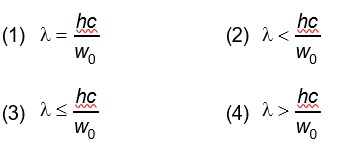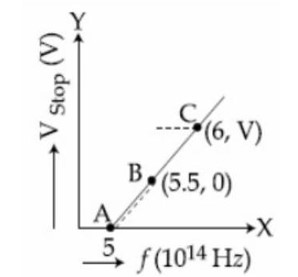Photons with energy 5 eV are incident on a cathode C in a photoelectric cell. The maximum energy of emitted photoelectrons is 2 eV When photons of energy 6 eV are incident on C, no photoelectrons will reach the anode A, if the stopping potential of A relative to C is
Photons with energy 5 eV are incident on a cathode C in a photoelectric cell. The maximum energy of emitted photoelectrons is 2 eV When photons of energy 6 eV are incident on C, no photoelectrons will reach the anode A, if the stopping potential of A relative to C is
Option 1 -
+3V
Option 2 -
+4V
Option 3 -
-1V
Option 4 -
-3V
-
1 Answer
-
Correct Option - 4
Detailed Solution:According to Einstein’s photoelectric equation maximum kinetic energy of photoelectrons,
or
When then,
or
or
Similar Questions for you
For no emission of electron
λ > λ0

Intersity a number of photons kinetic Energy a f
Incident energy
If electron will emit.
No electron emission
Only caesium will emit electron
Relation between De-Broglie wavelength and K.E. is
Taking an Exam? Selecting a College?
Get authentic answers from experts, students and alumni that you won't find anywhere else
Sign Up on ShikshaOn Shiksha, get access to
- 65k Colleges
- 1.2k Exams
- 681k Reviews
- 1800k Answers


